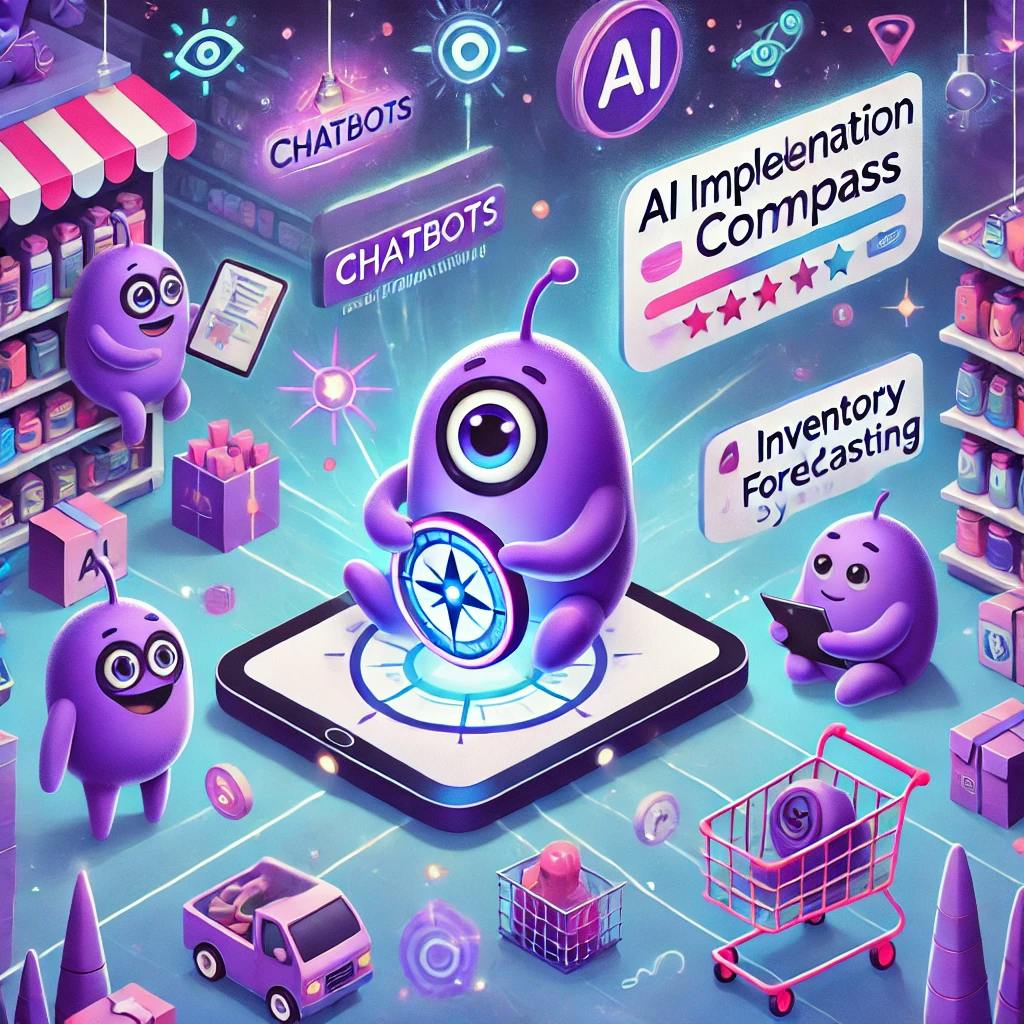The Growing Role of AI in Retail
Artificial intelligence is reshaping the retail industry, revolutionizing how businesses operate, make decisions, and interact with customers. From personalized shopping experiences to optimized supply chain logistics, AI’s footprint is expanding rapidly. Retailers are leveraging AI to analyze vast amounts of consumer data, providing insights into purchasing behaviors and preferences. This data-driven approach enables businesses to tailor marketing strategies and product recommendations, creating a more personalized shopping experience.
Moreover, AI is enhancing operational efficiency. For instance, AI algorithms predict demand more accurately, helping retailers manage inventory levels and reduce waste. Machine learning models forecast trends, ensuring that stores stock the right products at the right times. In logistics, AI optimizes delivery routes, cutting costs and improving delivery speed, which is vital in an era where consumer expectations for quick shipping are high.
Customer service is another area where AI is making strides. Retailers use AI-powered chatbots to handle routine inquiries, offering instant support and freeing human agents for more complex interactions. This not only improves customer satisfaction but also reduces operational expenses.
As AI’s role in retail continues to grow, understanding its application and strategic integration becomes crucial. The AI Implementation Compass, discussed in the next section, offers a structured approach to navigating these technological advancements effectively.
Understanding the AI Implementation Compass
The AI Implementation Compass is a strategic tool designed to aid retail organizations in successfully integrating artificial intelligence into their value chains. Picture it as a guiding framework helping retailers navigate the often-turbulent journey of AI adoption. At its core, the compass identifies key elements crucial for managing change.
In simple terms, it breaks down the integration process into manageable parts. It considers factors across various levels: from individual roles within a company, to departmental functions, all the way up to the larger organizational network. Each level has unique challenges, and the compass shines a light on these, providing clear directions on how to address them. For example, while aligning AI technologies with your existing systems, you may encounter technical hitches or resistance from staff unfamiliar with AI. The compass guides you in setting up training sessions or aligning workflows to ensure seamless integration.
Moreover, it underscores the importance of balancing technical advancement with human aspects. It’s not just about introducing new algorithms or data analytics; it’s about preparing your team and infrastructure for a transformative shift. Think of it as blending the art of change management with the science of AI. By following the compass, retail organizations can streamline AI adoption, minimizing disruption while maximizing operational benefits.
Micro-Level Challenges in AI Adoption
Navigating the integration of artificial intelligence within retail involves untangling intricate human dynamics at the micro-level—an aspect often overshadowed by high-level strategies. At this foundational level, employees’ apprehension and skill deficiencies represent significant hurdles. Imagine an employee who’s accustomed to decades-old manual inventory practices suddenly asked to engage with an AI-driven system forecasting stock requirements. The anxiety stems not just from learning a new tool but also from fear of obsolescence.
Recognizing these human elements requires empathy and structured intervention. Retailers must first identify the knowledge gaps. Conducting skills assessments provides a clear map of where employees stand versus where they need to be. Training programs, tailored to bridge these gaps, should be interactive and iterative, allowing employees to ease into new systems comfortably, ensuring they’re equipped with the necessary AI literacy.
Moreover, creating forums for discussions can combat resistance. Consider implementing regular workshops where employees can voice concerns and suggest improvements. This helps in making them stakeholders in the change rather than reluctant participants. Realigning organizational culture to emphasize learning and growth over immediate compliance nurtures an environment of innovation and reduces friction.
Supporting employees through these micro-level challenges doesn’t just ensure smoother AI integration; it builds a culture primed for adaptation, where employees feel valued and informed, ready to navigate AI’s evolving landscape.
Meso-Level Dynamics: Bridging Departments
The meso-level dynamics of AI integration in retail involve navigating the intricate web of inter-departmental relationships. Successful implementation hinges on seamless collaboration among various departments, such as marketing, sales, and logistics. Each of these sectors often operates in silos, contributing to communication barriers that can stall AI deployment. For instance, the marketing team might focus on AI tools for customer analytics, while logistics prioritize supply chain optimization. Without proper communication, these departments may miss opportunities for synergistic innovations that maximize AI’s potential.
To overcome these challenges, fostering a culture of cross-departmental collaboration and communication is paramount. Regular inter-departmental meetings and workshops can serve as platforms for knowledge exchange, allowing teams to understand different perspectives and align their AI strategies. For example, sales and marketing departments might collaborate on a unified AI-driven customer engagement strategy, drawing from both customer insights and sales data.
Furthermore, appointing a project manager who understands the language and needs of each department can aid in translating AI objectives into actionable plans that respect existing workflows yet encourage cross-functional efforts. This central figure can facilitate a shared vision, ensuring that AI tools are integrated in a manner that respects and enhances each department’s unique contribution to the retail value chain.
Macro Environmental Influences
Retailers diving into the world of artificial intelligence face powerful macro environmental influences. A landscape shaped by currents of market trends, regulatory pressures, and competitive dynamics presents both opportunities and challenges. Start with market trends: consumers are rapidly embracing technology, demanding personalized experiences. This evolution pushes retailers to meet these expectations through AI, which can analyze consumer data and predict buying habits. Companies that fail to innovate risk losing relevance.
Simultaneously, regulatory frameworks impose critical boundaries. Governments worldwide are scrambling to set rules that ensure ethical AI use, addressing concerns around data privacy and algorithmic transparency. In retail, this means balancing innovation with compliance—a tightrope act that requires vigilance and adaptability.
Competition further intensifies the urgency. With heavyweights like Amazon or Alibaba aggressively leveraging AI, others must keep pace or risk obsolescence. These giants use AI to enhance logistics, customer service, and inventory management, setting a high bar for industry standards.
Layered over these factors is the global economic climate, influencing investment capacities and technological advancements. As economic conditions fluctuate, resource allocation toward AI projects can wax and wane, impacting the pace and scale of integration.
In this intricate web, retailers must skillfully navigate macro influences to effectively integrate AI, ensuring they remain competitive, compliant, and consumer-centric in today’s market.
Socio-Technical Systems Theory: A New Lens
The integration of artificial intelligence (AI) into the retail sector is intricately challenging, intertwining technology’s mechanical precision with the unpredictability of human behavior. This delicate balance is where socio-technical systems theory offers considerable insights. By perceiving AI implementation through both technical and social lenses, retailers can better navigate this complex landscape.
Technical elements might focus on hardware, software, and data frameworks vital for AI deployment. However, the real magic, and often the most daunting challenges, lie within the social dimension. Employees, for instance, may feel threatened by AI-enhanced tools fearing job redundancy, or overwhelmed by the intricacies of new systems. Sociotechnical systems theory suggests that successful AI integration is dependent not only on the robustness of these technological components but also on addressing the human aspects involved in this transition.
In practical terms, this could mean actively involving frontline employees in AI training programs or creating open forums to express concerns and suggestions about the technology. Retailers might observe more cohesive adoption by reconfiguring team structures to foster collaboration between tech-savvy staff and those with domain expertise, ensuring that AI solutions are informed by practical, day-to-day retail operations. Ultimately, treating AI integration as a socio-technical challenge moves the organization beyond mere installation, toward holistic adoption that respects the human elements intertwined with technological advancements.
Leavitt’s Diamond Model in AI Implementation
Leavitt’s Diamond Model offers a structured way to dissect the complexities of AI integration in retail by focusing on four core dimensions: structure, technology, tasks, and people. This model is instrumental because it forces us to consider how these elements interact and impact each other when AI disrupts retail operations.
Let’s start with structure. Retailers must assess their organizational frameworks to see how AI tools fit or demand adjustments. It might mean redefining roles or creating new departments that focus on AI oversight, ensuring the chain of command is equipped to handle AI-driven insights.
On the technology front, AI isn’t just another digital tool—it’s transformative. For successful integration, retailers must ensure their existing tech infrastructure is compatible with AI systems. This often involves upgrading legacy systems, which can be costly and time-consuming but crucial for seamless operations.
When it comes to tasks, AI changes how work is done. Retailers need to re-engineer processes, so AI complements human efforts rather than replacing them. For example, AI can handle data analysis, allowing staff to focus on strategy and customer interaction.
The people element is perhaps the most sensitive. Employees must be trained and reassured about AI’s role. This involves communication strategies to mitigate fear of job loss and highlight AI’s potential to improve job satisfaction through automation of mundane tasks.
Considering these dimensions using Leavitt’s Diamond Model allows retailers to foresee potential bottlenecks and align AI integration with their strategic objectives, creating a smoother transition into AI-driven retail ecosystems.
Case Studies of Successful AI Integration
Retailers who master AI integration often leverage the AI Implementation Compass to guide them through the intricacies of this technological transition. Successful narratives emerge from companies like Walmart and Stitch Fix, offering a blueprint for others to follow. At Walmart, harnessing AI to optimize supply chain operations has minimized stock discrepancies and improved inventory management. This technological shift wasn’t abrupt; it involved a coherent strategy that aligned technological upgrades with task redefinitions and staff training, a move inspired by components of Leavitt’s Diamond Model from the previous section.
In contrast, Stitch Fix has redefined customer engagement through AI-led personalization. By deploying complex algorithms to understand consumer preferences, they revolutionized their task structures to align with new technological capabilities. This adaptation not only enhanced customer satisfaction but also reshaped their workforce, creating roles geared towards data analysis and algorithm training.
These companies exemplify how understanding and navigating the socio-technical systems can lead to successful AI adoption. They illustrate the importance of connecting technological innovations with clear task modifications and human resource alignment, emphasizing collaboration between technical experts and retail managers. Consequently, these case studies reinforce that profound comprehension of structural and people dynamics is crucial in bridging traditional retail methodologies with progressive AI capabilities.
Future Trends and the Evolution of AI in Retail
Managing change during AI integration in retail requires a nuanced approach that aligns technology with human elements. At the heart of this process lies the AI implementation compass—a strategic framework guiding organizations through complex transitions. This tool is crucial for aligning technological advancements with organizational goals and employee capabilities.
A key aspect of successful AI integration is understanding the socio-technical dynamics at play. Organizations must address how AI impacts the existing workflow and employee roles. For instance, implementing AI-driven inventory systems can streamline stocking processes but may require retraining staff to interact with new interfaces. Open communication is vital, ensuring all stakeholders understand AI’s benefits and potential disruptions.
Moreover, dismantling silos across departments fosters collaborative environments essential for AI success. When marketing, operations, and IT teams work cohesively, they better anticipate challenges and allocate resources efficiently. Training programs tailored to diverse learning styles can ease transitions, ensuring employees feel valued and prepared.
Externally, staying attuned to market forces and customer expectations is imperative. Retailers must adapt AI solutions that not only enhance operational efficiency but also elevate customer experiences, such as personalized shopping recommendations. This alignment ensures that AI integration is not an isolated initiative but a comprehensive strategy propelling retailers toward sustainable growth.
Expert Perspectives on Navigating AI Implementation
Incorporating AI into retail is not merely a technological shift, but a strategic reimagining of the retail ecosystem. Insights from experts like Jeandri Robertson highlight the importance of aligning AI initiatives with responsible marketing. Robertson emphasizes understanding digital ecosystems to promote sustainable practices. For instance, when retailers integrate AI in customer service, it’s crucial they do so with a strong ethical framework to safeguard customer data and privacy.
Elsamari Botha insists on the importance of clear digital strategies when adopting AI. She asserts that retailers must first define what they aim to achieve with AI. From personalizing shopping experiences to optimizing supply chains, a well-defined strategy directs the successful integration of technology without losing sight of business goals. Botha draws on her extensive experience, noting that businesses often falter when they adopt technology without a comprehensive understanding of its potential and limitations.
Kim Oosthuizen emphasizes the need for a supportive organizational culture. Engaging with AI requires adaptability from all levels of a business, from executives to frontline employees. Oosthuizen, drawing from her experience at SAP, advocates for internal education programs to help employees understand and embrace AI technologies.
Thus, integrating AI into retail demands more than technical infrastructure. It requires a symbiotic blend of strategy, ethical considerations, and cultural adaptability, ensuring AI’s potential is fully realized while aligning with future trends in retail innovation.
😈
k bye.











